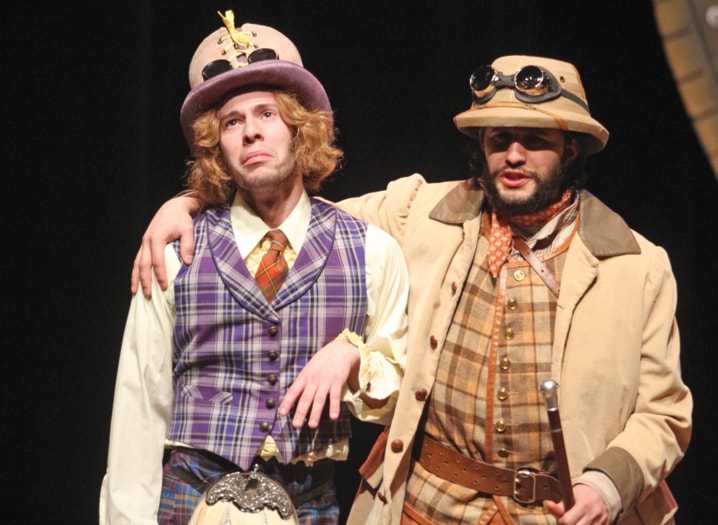Bring on the lace-up corsets, neo-Victorian goggles, and plenty of cranks and gears.
William Shakespeare’s gender-bending comedy of mismatched lovers, Twelfth Night, is getting the steampunk treatment when it opens on Thursday at the Red Deer College Arts Centre.
The anachronistic genre, as envisioned by the sets and costumes of movies such as Sleepy Hollow, Lemony Snicket’s A Series of Unfortunate Events and The Brothers Grimm, imagines a past that never was.
In this murky neverland, the technological inventiveness of Jules Verne’s novels and the intricate fussiness of Victorian fashions can coexist with modern embellishments. The result is what might have happened if the steam-driven industrial revolution ran amuck through the decades, smashing into the zeppelins and Art Deco furnishings of the 1920s or ’30s, and the sleek car designs of the ’40s and ’50s.
With its top hats, frills and dandy waistcoats, steampunk fashions embrace androgyny. And the play’s guest director, Duval Lang, of Calgary, believes this look is perfect for a play about a girl — the aristocrat Viola — who gets hired by Count Orsino by pretending to be a boy.
“Steampunk features a blending of genders, of girls dressing as men. It’s where society might have gone if history took us in a different direction. It’s very appropriate for this play,” added Lang.
While the genre’s costumes tend to be dark and sooty looking, colours will be punched up to reflect that Twelfth Night is a comedy, said guest costume designer Brian Bast. The Edmonton-based graduate of RDC’s acting program has been busy creating cinch-waisted Victorian dresses with cropped skirts, pin-striped men’s trousers, and some wacky hats with goggles — including one encircled by a girdle.
The set for Twelfth Night will feature a large brass compass and wire and metal installations that resemble either trees or sails. There are circular stairs and a platform, and lots of set pieces that need to be lowered from the rafters — including Olivia’s swing.
Lady Olivia sets the plot in motion when she refuses to consider a proposal of marriage from love-lorn Count Orsino. Set designer Carrie Hamilton envisioned the spoiled Olivia petulantly swinging herself back and forth, as she has a temper tantrum about the count’s offer.
“She’s young. She doesn’t want to settle down yet,” said Hamilton. Olivia uses the excuse that she’s in mourning for her dead brother and not in a position to marry.
But Count Orsino is not one to take rejection to heart. He hires Viola (whom he thinks is a young man called Cesario) to woo Olivia for him. The trouble is, Viola makes such a comely young man that Olivia ends up falling for him/her.
The double catch is that Viola is secretly in love with Count Orsino, herself, and doesn’t want him to marry Olivia.
And so the dysfunctional love triangle is complete — with Viola in love with Orsino, Orsino smitten with Olivia, and Olivia enthralled with Cesario, who is really Viola in disguise. Everybody is thoroughly miserable.
Fortunately, misery makes for great comedy, said Lang, who’s very excited by the opportunities presented by this Shakespearean play, and the chance to pass his enthusiasm on to Theatre Studies students.
Lang believes too many people associate plays like Twelfth Night with the dry readings and essays that were assigned in high school English class. “It was like cod liver oil being forced down your throat. . . .
“These plays weren’t mean to be read and studied,” he said. “They were meant to be performed” — and not just for a high-brow crowd.
Shakespeare played to the drunks in the front row as much as to the aristocrats in the balcony, added Lang, who co-founded Quest Theatre in Calgary and is a sessional instructor at the University of Calgary. “He wrote it for a pretty raucous audience and he meant it to be entertaining, with lots of humour.”
Lang’s first challenge was to help the 12 young cast members find the fun in the play, which meant discovering the rhythm in the speech and the meaning of the words.
When Shakespeare was writing some 400 years ago, people relied on music and language for their fun, said Lang. “They used the spoken word to show off,” speaking in longer, more eloquent sentences than we use today.
“Wit was exceedingly popular, and Shakespeare is chock-a-block full of double entendres.”
Lang hopes area theatregoers will put aside any biases they may have against Shakespeare and come out to see if everything ends well in the screwed-up world of Viola, Orsino and Olivia.
“The play really is a delightful romp. It’s all about love and the complications that can happen to you when you aren’t who you really are.”
lmichelin@www.reddeeradvocate.com
